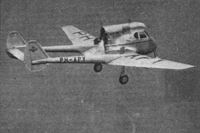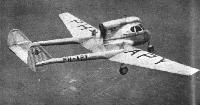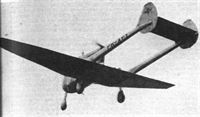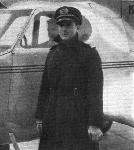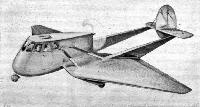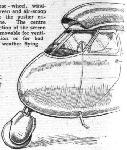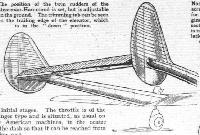Stearman-Hammond Y-1
Компания "Stearman-Hammond Aircraft Corporation" была создана в 1936 году и позволила конструкторам Ллойду Стирману и Дину Хэммонду объединить усилия для разработки самолета Hammond Model Y и запуска его в серию. Самолет получил обозначение Y-1 (Y-125), он рассматривался как простой в пилотировании и был предназначен для широкого круга заказчиков. Самолет представлял собой свободнонесущий низкоплан балочной схемы с центральной гондолой, в которой рядом располагались два кресла, а двигатель Menasco C-4 мощностью 125 л. с. с толкающим воздушным винтом располагался сзади. Шасси - неубирающееся трехопорное, размах крыла - 12,19м.
Y-1 строился в небольшом количестве и имел недостаточно привлекательные летные характеристики, поэтому позже был разработан вариант Y-1S с двигателем Menasco C-4S мощностью 150 л. с., который на высоте 915 м развивал максимальную скорость 209 км/ч. Всего удалось построить 20 машин.
Model Y использовался в качестве учебно-тренировочного в голландской авиакомпании KLM, а также проходил оценочные испытания в ВМС США й британских ВВС. Последние приобрели самолет у KLM. Машина, получившая регистрационный номер R2676, была списана в начале 1942 года.
Показать полностьюShow all
Flight, November 1934
TOWARDS THE "FOOLPROOF" IDEAL
The Hammond Model Y: A Two-seater "Pusher" for the U.S. Department of Commerce
ABOUT a year ago Mr. Vidal, of the U.S. Department of Commerce, startled the American aircraft industry by stating that he believed that there was a market for 10,000 easily flown, safe aeroplanes, provided they could be sold for 700 dollars each. It subsequently appeared that he might be granted a fund to assist him in proving the truth of his contention, but the money was not forthcoming, and so he called for bids on twenty-five small economical aircraft to replace the machines in use by inspectors of the U.S. Department of Commerce. Last month a contract was awarded to the Hammond Aircraft Company, of Ypsilanti, Michigan, for fifteen of the originally specified twenty-five at a cost of 2,190 dollars each.
According to Western Flying, it was stipulated that the machine to be ordered must be capable of clearing a 35-foot obstacle 800 ft. from a standing start; that it must be capable of being brought to a stop within 400 ft. of the same obstacle, cleared in a straight and controlled glide by a private pilot; that no movement of the control or sudden loss of power should cause either a spin or a steep recovery dive; that the undercarriage should withstand a landing with a vertical velocity of twenty feet per second; that both pilot and passenger should have an uninterrupted view; and that the machine should be capable of being brought to a stop in 150 it. from a ground speed of 45 m.p.h.
The Hammond Model Y will resemble few aeroplanes that have been produced during the past few years - with the exception, perhaps, of the Stout "Skycar." It will be a low-wing three-wheeled "pusher" cabin monoplane of all-metal construction with the pilot and passenger seated side by side. The tail will be carried on two booms and the engine specified is a four-cylinder inverted Menasco.
But it is in the three-wheeled undercarriage that the real interest lies. By arranging two normally braked wheels, braced through the wing by four struts to the cabin top, and an additional fully-castoring wheel in the nose, a number of operational advantages should be obtained, the most noticeable of which will be the ability to use the brakes really hard at all speeds without nosing over.
It is claimed also that the gliding angle can be made very steep for landing in small spaces, and that the actual landing can be made simply by pulling tho stick back. In any control position it will be impossible to stall the machine.
A good, but not exceptional speed range is promised - 35 to 110 m.p.h. Demonstrations will be made in March next year.
Показать полностьюShow all
Flight, November 1937
RATIONAL UNORTHODOXY
The Stearman-Hammond in England: Simplified Control System for All-metal Pusher with Tricycle Undercarriage
FOR three important reasons the Stearman-Hammond "Y," which was demonstrated last week for the first time in this country, is of more than usual interest.
In the first place, it represents a type which has been built round the tricycle type of undercarriage - and, as "Indicator" suggested in his article on the subject last week, this development really demands a clean sweep of many existing ideas. Secondly, a very real attempt has been made in its design to simplify (or, rather, to modify) the control layout so that any normally intelligent car driver should be thoroughly at home in it within a short time. Thirdly, the machine represents the first production fruits of the U.S. Bureau of Air Commerce's drive towards safer and easier flying for the average man or woman.
Among less important reasons are that it is of the pusher type, with all that this arrangement represents in the way of unlimited forward visibility and comfort, and that it is one more machine to continue the trend towards all-metal construction in the private-owner class. The fact that at the present time its price in this country is likely to be high is neither here nor there. If the demand in the States should justify the move, no doubt the Stearman-Hammond people will put the production on a mass basis and we shall be able to buy it for a sum which will be attractive to the ordinarily interested and well-off individual. Probably a twin-engined four-seater on the same lines would be a better all-round proposition for the world market.
This particular machine has been bought by K.L.M. for instructional purposes, since the next additions to this company's fleet - whether D.C.4S or Boeings is not yet settled - will undoubtedly have the tricycle type of under carriage. First Officer C. C. Steensma, one of the company's pilots, flew it over and gave a very convincing demonstration of its various capabilities.
Unfortunately some complicated Customs ruling adequately prevented anyone from flying in the machine either as a passenger or as a pilot, so no first hand impressions can be given. However, Mr. Steensma showed that it was at least as manoeuvrable as any other light aeroplane in the air and a great deal more manoeuvrable on the ground; that sink or glide-in landings could be made with impunity; and that a cross-wind landing results in neither a trailing wing-tip nor a sharp swing into wind. The wind was blowing at 10 m.p.h. or probably more, and the machine has no movable rudder, so that it was impossible for the pilot to cheat by providing artificial drift. The undercarriage just takes it, though with little keel surface one would expect the machine to swing down-wind without the positive control provided by the steerable nose-wheel once it is firmly on the ground.
In last week's issue the special characteristics of the tricycle undercarriage - foolproof landings and directional stability on the ground - were described and explained, so we may pass straight on to the control system of the Hammond. This, with its simplification, would not be a practical proposition, needless to say, without the tricycle arrangement, so that some undercarriage comment will be necessary. It will suffice for the moment to say that this landing gear has a stroke of 18 inches and will accommodate a vertical velocity of 20 feet a second - which is a good deal faster than the semi-stalled sinking speed of the machine and is equivalent to a free drop of 6 1/2 feet or so.
As already explained, the Hammond has no controllable rudder. Instead there are two fixed but adjustable fins which are normally arranged with a slight splay-out to provide directional stability in the air. Turns are wade on the differential ailerons and the elevator alone. Presumably the sort of jagging movement usually given to the ailerons in order to lift a wing after a bump is not likely to produce a turn of more than a degree or two, and the only difficulty likely to be experienced would be while flying on the instruments alone. Mr. Steensma told us that the technique of accurate two-control blind flying is, in any case, soon mastered.
In the side-by-side cabin there are five major controls, only one of which is used in ordinary flight - the wheeled control column. This is of the swing-over type and operates in the usual way except that, when taxi-ing, the aileron wheel is used as when driving a car, since its movement turns the nose-wheel. Incidentally, this nose-wheel movement has some slight action on the flying characteristics, the drag tending to assist the turn in its initial stages. The throttle is of the plunger type and is situated, as usual on the American machines, in the centre of the dash so that it can be reached from either seat.
On the pilot's right there is the large flap lever which has three ratchet-controlled positions - off, 20 deg. Down and 40 deg. down. At his feet are two pedals. That on the left, when depressed, lowers the flaps 20 deg. from the position in which they, are already set. In other words, if the main lever is fully forward and the flaps are up, its depression produces a 20-deg. movement, while if, as is normal during the approach, the lever is fully back (flaps at 40 deg.), movement of the pedal simply depresses the flaps farther for the landing. This arrangement, in the case of small-field flying, permits the pilot to "lever" the machine off the ground before it would otherwise be ready to fly, and also allows that last bit of drag to be applied at the end of the approach - in each case without the need for removing the hands from the wheel or the throttle. The pedal on the right applies the brakes on the main undercarriage in the ordinary way and there is a little parking catch just below it. A small crank on the control column operates the elevator tab. This is used only for accurate hands-off trimming, since there is practically no difference in the engine-on and engine-off trim.
The approach can, of course, be carried out in any variation of the normal manner, or, alternatively, on sit-down-and-do-nothing lines with the machine trimmed in a 50 m.p.h. glide right into the ground. The elevator control is limited so that the machine cannot be fully stalled without a preliminary dive and pull up. Even then the stall appears to be quite innocuous. Apparently, if one is so inclined, the machine can be brought all the way in with the control column right back, though this course of action is not likely to be recommended in bumpy conditions.
So far as general comforts are concerned, the Hammond cabin is reasonably wide for two people and the amount of lateral space is comparable with that provided in the Hornet Moth or the Whitney Straight. There is a large door and fixed step on each side, and a good deal of attention has been paid to the soundproofing and ventilating arrangements. Maps and incidentals can be accommodated on a shelf behind the seats, while there is a large luggage compartment beneath the engine. The machine is sold with full electrical and night-flying equipment, including a generator and electric starter.
K.L.M.'s machine is fitted with a supercharged C-4 Menasco of 150 h.p., but the standard machine has a 125 h.p. engine, and the performance figures in the panel on this page are those for the normal type.
STEARMAN-HAMMOND " Y"
125 h.p. Menasco C-4.
Span 40ft.
Length 26ft. 11m.
Height 7ft. 7in.
All-up weight 2,150 lb.
Payload 440 lb.
Maximum speed 120 m.p.h.
Cruising speed (75 per cent, power) 110 m.p.h.
Stalling speed 40 m.p.h.
Cruising range 550 miles
Distributors: N. V. Kon.-My. "De Schelde," Vlissingen, Holland.
Показать полностьюShow all
Flight, February 1938
SIMPLICITY from the STATES
Flying Impression of the Stearman-Hammond Pusher: Tricycle Training for K.L.M. Pilots. By “Indicator”
AS one of the first machines to be designed and built round the tricycle principle, and certainly the first to be seen in Europe, the Stearman-Hammond Y can hardly be laughed aside as a mere experiment of no particular consequence. The example bought by K.L.M. was demonstrated at Croydon late last year and was described in Flight of November 18. Unfortunately, on that particular day, Customs’ arrangements then prevented any interested person, however obviously a non-buyer, from riding in the machine (and certainly from flying it), but K.L.M. and the Netherlands authorities generally, rather less entangled in red tape, recently provided me with the necessary facilities at Schiphol aerodrome, Amsterdam. Which, in view of the fact that neither is actively interested in the sale of the machine, was particularly altruistic of them and in keeping with a co-operative spirit which is not, unfortunately, by any means universal even in the flying world.
At Schiphol the Hammond was entirely in its element, since the full effect of a good tricycle arrangement can best be appreciated on asphalt runways. The work of flying the machine consisted simply of (a) taking-off by driving it along the runway until a certain pre-determined speed was showing on the A.S.I., pulling it firmly off and trimming in due course to level flight; and (b) landing by gliding it straight in on to the end of the chosen asphalt strip and applying the brakes just as vigorously as one felt inclined. During this crash stop process (carried out by a K.L.M. pilot by way of demonstration and leaving two black lines on the white surface of the runway) there was little or no tendency for the machine to swing ofl the straight course.
Probably the non-pilot, sitting in the machine for the first time, would, with a little verbal assistance, put up as good a show as anybody else. There is the Hammond's slight weakness, because the majority of the people who are interested in it are those who have already learnt to fly and certain things must immediately be unlearnt. However, after five minutes or so my feet forgot to clamour for the non-existent rudder control, and a natural instinct to hold off in the conventional manner had already to some extent been overcome in previous tricycle experimentations.
By way of learning exactly what might happen, I did my best, on the first landing, to pull off a full three-pointer. The Hammond managed a half-hearted wheeler and remained poised with the tail in an intermediate position for perhaps two seconds; then the outfit sank gently forward on to its nose-wheel. For the benefit of those to whom the Hammond control arrangements are unfamiliar, it should be explained that there is no rudder control, turns being made on the ailerons alone, and my interest in the conventional landing was largely that of discovering whether, during the short time in which no directional control was available, the machine would swing momentarily one way or the other. It carried on in a rigidly straight line during those two interesting seconds.
Steering Car-fashion
The take-off run is normally made with the control columns more or less in the neutral position, and the steering is done, car-fashion, with the aileron control, which is connected to the front wheel. One's natural tendency, I should imagine, is to over-steer, though I suffered no trouble from this cause. With commendable caution I waited for something to happen before making any wheel movements. Left to itself and with the trimming crank moved so that the little indicator is approximately in its neutral position, the machine simply runs along in a straight fine with little or no tendency to buck.
For better or for worse, the Hammond will not take itself off even when trimmed right back. Having accelerated until the A.S.I. shows about 90 km/hr. (55 m.p.h.) the wheel is hauled firmly back almost to its full extent, and as soon as the machine has left the ground it is eased forward momentarily whilst more speed is gathered. The flap lever is not used, nor is the flap pedal, which applies additional 20 degrees to anything already set (or not set) by the main lever; apparently what little improvement can be obtained in take-off distance is nullified by the additional drag.
It might be asked how, if the ailerons are used for turning purposes, bumps may be corrected without a good deal unnecessary yawing. The effect of the aileron control, however, depends entirely upon the way in which it is used. A gradual, firm and comparatively slow motion immediately produces an accurate turn in either direction, while a sharp tug lifts a wing without any appreciable deviation from the straight path. In changing from a steep turn in one direction to a similar turn in the other direction, there need be no perceptible skid if a little care is used, and deliberately careless handling does not produce any seriously untoward motions. By means of a weaving motion of the aileron control it is just possible to produce a rather feeble skidding sideslip which might be useful for losing unnecessary speed during the last part of the approach, though with four-position flaps it is difficult to see any possible reason for such manoeuvres.
The approach can be carried out in an almost unlimited number of ways, varying from a flat, unflapped glide (using the flaps, by lever and/or pedal, to get rid of surplus speed at the very end) to a fully flapped semi-stalled glide started practically from a point above the aerodrome boundary. The Hammond's stall is almost entirely innocuous, and the worst that happens if the speed is allowed to drop too far is a momentary dropping of the nose. Consequently, and remembering the limited elevator movement, it is possible to bring the machine, in at 80 km/hr. (50 m.p.h.) with perfect safety so long as the vertical velocity is kept within reasonable limits.
For this reason, no doubt, a rate-of-descent indicator is part of the standard equipment, and its readings can be watched so that the undercarriage is not given more than it can take. It has been designed to deal with a maximum vertical velocity of metres a second, though a touchdown made at this indication should obviously be an entirely symmetrical one. Since there is not a very great measure of control at such low speeds it is obviously advisable to prevent this sinking speed from exceeding 3 metres a second. All of which is mentioned to explain the possibilities of the type and it is not suggested that normal approaches will ever be made in this manner; if, however, a pilot is incautious with his approach speed the machine should come to no very serious harm.
Needless to say, the machine being a pusher, the view in essential directions is excellent, but it is impossible to see directly backwards, and the necessary airscoop for engine cooling precludes the arrangement of a roof window. Consequently, the effect as a whole is that the range of vision is little better than average.
It would probably be fair to say that the Hammond flies on its ailerons alone no more effectively at normal speeds than one or two of our own light aeroplanes, but directional control is effective in this way right down to stalling point. On one occasion, misjudging the position of the end of a runway by a matter of two or three yards, I found no difficulty in making a complete S-turn at a speed of about 95 km/hr. (58 m.p.h.). In fact, the only curiosity of slow-speed flying with the Hammond concerns a shuddering of comparatively slow rhythm when the A.S.I. shows anything much less than 90 km/hr. This mild shaking occurs at a somewhat higher speed when climbing steeply on full throttle, and for the moment I thought it was a period in the Menasco engine. Apparently it is an effect of the airflow.
As a machine for the private owner’s use the Hammond possesses certain minor disadvantages, the most noticeable of which is a comparative lack of lateral space in the cabin. This is somewhat exaggerated by the presence of a control column between the seats, and of the flap lever which, in order to provide adequate leverage for direct operation, is a very long one. Nor is the cabin really as quiet as it ought to be.
The somewhat natural impression of the person who sees the Hammond for the first time is that it is ugly. That may be so, but one becomes accustomed to its appearance, which at least is workmanlike, and it must be remembered that we have become used to machines of a very different shape.
In its standard form the Stearman-Hammond is fitted with full electrical equipment, including navigation lights and a self-starter, so the awkward position of the engine and airscrew is not, perhaps, so very important. However, generators fail and batteries run down, and one must feel a certain amount of sympathy for the pilot who might have to stand on the centre section and swing the airscrew by hand. But we put up with a complete lack of self-starting apparatus on the majority of our light aeroplanes. Nor are any of these perfect, so such complaints must be taken as an indication of the Hammond’s excellence in essential arrangements.
STEARMAN-HAMMOND Y.
125 h.t. Menasco Pirate C-4*
Span 40ft.
Length 26ft. 11in.
Height 7ft. 7in.
All-up weight 2,150 lb.
Payload 480 lb.
Maximum speed 120 m.p.h.
Cruising speed (at 75 per cent, power) 110 m.p.h.
Stalling speed 40 m.p.h.
Cruising range 500 miles.
Distributors: N.V. Kon.-My. "De Schelde,” Flushing, Holland.
* The machine dealt with is fitted with the supercharged version of this engine.
Показать полностьюShow all











